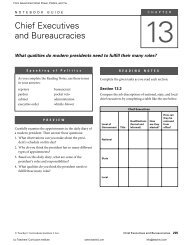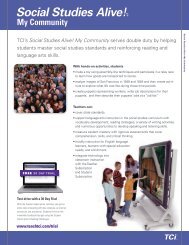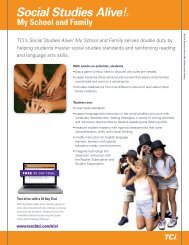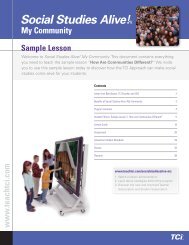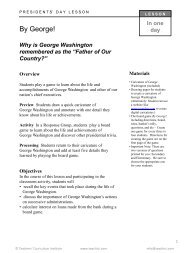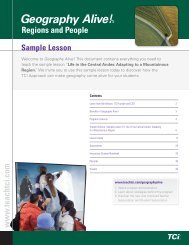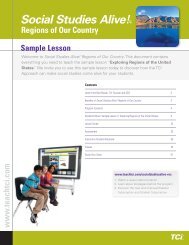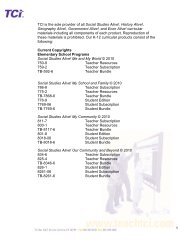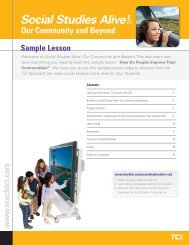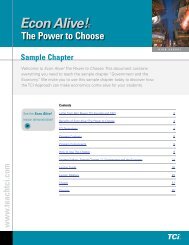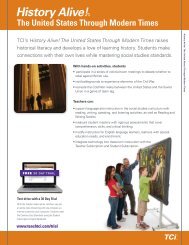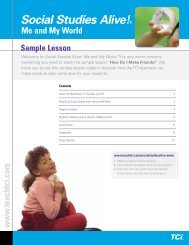Bring Learning Alive! Skill Builder Chapter - TCI
Bring Learning Alive! Skill Builder Chapter - TCI
Bring Learning Alive! Skill Builder Chapter - TCI
- No tags were found...
You also want an ePaper? Increase the reach of your titles
YUMPU automatically turns print PDFs into web optimized ePapers that Google loves.
Methods to Transform SecondarySocial Studies Instruction(c) Teachers' Curriculum Institute www.teachtci.com info@teachtci.com
Multiple Intelligence Teaching StrategiesSocial Studies <strong>Skill</strong> <strong>Builder</strong>Steps at a Glance123Use engaging tasks toteach social studies skills.Teach the skill throughmodeling and guidedpractice.Prepare students to workin pairs.Introduction<strong>Skill</strong>s such as mapping, categorizing, analyzing primary sources, graphing andinterpreting graphs, and reading a timeline are a vital part of any middle andhigh school social studies course. Without these skills, students will not fullygrasp many concepts. Why teach about the Proclamation of 1763, for example,if students cannot locate the Appalachian Mountains on a map? Why compareand contrast ancient Greece and imperial Rome without first teaching studentshow to use a simple matrix or Venn diagram?45Set clear expectations,allow students to practicethe skill repeatedly, andgive immediate feedback.Debrief the lessonto help students makeconnections to key socialstudies concepts.Despite the importance of teaching these basic social studies skills, manyinstructors reserve little time for—and apply even less creativity to—this task.In the words of one high school history teacher, “I don’t have time to coversocial studies and teach skills. Students should come prepared from the lowergrades. Besides, when I do teach skills, my students say it’s boring.”The Social Studies <strong>Skill</strong> <strong>Builder</strong> strategy in the <strong>TCI</strong> Approach turns the traditional,rote tasks usually associated with skill-based worksheets into more38 <strong>Bring</strong> <strong>Learning</strong> <strong>Alive</strong>!(c) Teachers' Curriculum Institute www.teachtci.com info@teachtci.com
dynamic, interactive activities. Students work in pairs on fast-paced, skill-orientedtasks such as mapping, graphing, identifying perspective, and interpreting politicalcartoons. The teacher begins an activity by quickly modeling the skill and thenchallenging students to practice the skill repeatedly. Students receive immediatefeedback as they work. The activity ends with a debriefing session that allows studentsto use their new skill to gain greater insights into key social studies concepts.S T E P1Use engaging tasks to teachsocial studies skills.Teaching the basic skills that students need to be successful forsocial studies may seem daunting, especially if you and your classperceive such work as boring. With Social Studies <strong>Skill</strong> <strong>Builder</strong>s, the skills areimparted through lessons that both you and your students will enjoy. Here aresome tips to conducting skill-driven activities that are inherently engaging:Use stimulating resources that lend themselves to multiple-ability tasks.Good primary source documents are intriguing and offer students a real pieceof history to analyze. For an activity on the use of propaganda in World War I, acolorful collection of posters from that era, depicting the points of view of boththe Central Powers and the Allies, invites students to look for bias. A collectionof labor songs from the Great Depression, drawings of key inventions during theChang Dynasty, or political posters from a presidential campaign all can be thebasis for exciting lessons.“I thought I was incapableof learning history. Before itwas just a textbook,lectures, and a bunch ofjumbled facts. But the waythis class was organizedmade sense. It really madehistory clear.”— High School StudentChallenge students to use multiple intelligences during the activity. For example,during the World War I propaganda activity, students view a reproduction ofa wartime poster. Pairs quickly sketch the poster, search for symbols, discuss theposter’s meaning, and record their answers. In this process, they are using linguistic,visual, interpersonal, and logical-mathematical intelligences.Encourage student pairs to work as a team, but require them to recordinformation individually. Even though students work with partners, they areindividually accountable for all content and have their own work to complete. Inthe World War I propaganda activity, after jointly discussing the poster, each studentfills in a matrix that has columns for noting the caption, describing the symbols,and recording interpretations. Each student thus creates a personal record ofwhat the pair discussed. Recording what they talked about helps students be specificand remember their ideas—and enables you to assess individual progress.Give your students the opportunity for repeated hands-on practice. Start withan assortment of similar resources (photographs, drawings, quotations, songs)to give students lots of different pieces to analyze in the same way. Then providehandouts—maps, matrices, lists of questions, graphing paper—with space forstudents to practice the same skill many times. For example, for an activity aboutAmerica’s rapid industrialization, you provide a series of placards, each containingan image and a line graph, that together illustrate some aspect of industrialismin the early 1900s—such as the amount of raw steel produced, or the miles ofSocial Studies <strong>Skill</strong>s <strong>Builder</strong> 39(c) Teachers' Curriculum Institute www.teachtci.com info@teachtci.com
For a Social Studies <strong>Skill</strong><strong>Builder</strong>, students sit in pairsand work as a team to solveskill-oriented problems.railroad track in operation. Pairs examine a placard and, using the informationin the image and graph, answer questions from a matrix on their handout. Whenthey finish, they select a new placard and repeat the process. In this way, studentshave several opportunities to practice interpreting a line graph and relating thedata to industrial growth.Spiral from the basic to the complex to give students deep historical insights.The structure of a Social Studies <strong>Skill</strong> <strong>Builder</strong> should spiral from the simple to themore complex, challenging students to answer progressively higher-level questions.For example, consider an activity that focuses on disagreements over slaverybefore the Civil War. A series of placards provides pictures and information aboutkey historical figures. Students start by identifying each figure by name and bystate of residence. Second, they describe that person’s views on slavery. Third, theydescribe actions taken by the figure that exemplify his or her views. This spiralingallows students to discover increasingly complex information, preparing themfor a final discussion of such questions as these: Was owning a slave ever justified?Which groups in the South benefited most from slavery? How did slavery affectthe moral climate of our nation? Most students participate enthusiastically in thishigh-level discussion because they now have the knowledge base from which toexpound about perspectives. The spiraling allows each student to understand andarticulate complex issues.40 <strong>Bring</strong> <strong>Learning</strong> <strong>Alive</strong>!(c) Teachers' Curriculum Institute www.teachtci.com info@teachtci.com
S T E P2Teach the skill through modelingand guided practice.Introduce each Social Studies <strong>Skill</strong> <strong>Builder</strong> by quickly modeling andleading your students through guided practice of the skill. Modelingconsists of demonstrating and explaining the steps your students are to follow asthey develop the skill on their own. Here, for example, is the way you could modela Social Studies <strong>Skill</strong> <strong>Builder</strong> activity on mapping physiographic features of theUnited States:1. Give students an outline map of the United States. Have them point tonorth, east, south, and west on their maps, draw a compass rose in thesoutheast corner, and label the cardinal and intermediate points. Project atransparency of the same map, and demonstrate drawing the compass roseon the transparency.“This strategy has changedhow my students react togeography lessons. Insteadof saying, ‘Oh, we have todo another map,’ they say,‘Great, we get to do somethinginteresting.’ Havingthem work in pairs createssocial interaction that addsspice and allows them toshare the burden on toughassignments.”— High School Teacher2. Write the term physiographic feature on the map transparency. Explainthat physio means “physical,” graphic means “written down or recorded,” andfeature means “a particular characteristic of something.” Thus, a physiographicfeature is a physical characteristic of the land—such as a lake, mountain, orriver—that is recorded on a map.3. Tell students that they will now use their geographic knowledge to answer aset of map-hunt clues. They will record on their outline map the location thatis indicated by each clue, labeling a specific location or drawing in a physicalfeature such as a principal river, mountain range, or flatlands.4. Show students how to create a key in onecorner of their map. Demonstrate possiblesymbols for open water, rivers, mountains,valleys, and flatlands.One key to success is carefuland thorough modelingof the task to be completedby students.5. Read a map-hunt clue, such as This is thelargest bay along the California coastline.Ask students to use their atlases to find theanswer. When they do, label the San FranciscoBay on the map transparency, including thesymbol for water, and ask students to do thesame on their maps.6. Tell students they will now use theskill they just learned, labeling a physiographicmap, to answer a full set ofmap-hunt clues.This kind of modeling and guided practiceensures that students are ready to practice theskill on their own.Social Studies <strong>Skill</strong>s <strong>Builder</strong> 41(c) Teachers' Curriculum Institute www.teachtci.com info@teachtci.com
“Working in pairs helps mebecause I get to explain mythoughts and get anotheropinion.”— High School StudentS T E P Prepare students to work in pairs.After you have modeled the skill, place students in pairs. Because3students will be discussing skill-oriented questions with discrete,defined answers, working in pairs is ideal. Pairs have more opportunityfor interaction and will stay on task more easily than they would in a largergroup. Here are some tips for preparing for paired skills work:Carefully establish mixed-ability pairs. Since these skill tasks require the use ofmultiple intelligences, it makes sense to pair students with complementary abilities.This will help ensure that each partner has something of value to contributeand that interaction is more equitable. If an activity requires linguistic and visualskills, for example, try to put a strong linguistic student with one who excelsvisually. You shouldn’t need to spend more than 15 minutes of prep time on thispairing process, and it is time well spent, as it will result in students workingtogether much more effectively.Before class, prepare a transparency that shows who will sit where. On atransparency, draw a permanent classroom map showing the arrangement of deskpairs. Make sure your map shows desks placed evenly around the classroom, bothto limit distractions and to allow you to move freely among the pairs. Use anerasable marker to write students’ names next to the desks at which you wantthem to work. This will help students move efficiently into pairs.When students have foundtheir partners, have themintroduce themselves.Instruct students in each pair to sit side by side with the edges of their deskstouching. Project the map for students to use as a guide for arranging their desks.Tell them they are not officially a team until the right edge of one desk is touchingthe left edge of the other desk and both students are seated facing forward.Encourage students to greet each other.Once students have found their partnersand are sitting correctly, tell them tointroduce themselves and shake hands.Model this behavior with one of yourstudents. If appropriate, use humor toease the tension; it will help pairs worktogether more effectively.Conduct a quick team-builder to warmup students for working together. Thismight be as simple as having studentsrepeat this statement “Partner, if youneed a helping hand, I’m here to help.And if I need a helping hand, I’m countingon you.” Or, you might ask them todiscuss a question related to the skillthey will be learning.42 <strong>Bring</strong> <strong>Learning</strong> <strong>Alive</strong>!(c) Teachers' Curriculum Institute www.teachtci.com info@teachtci.com
S T E P4Set clear expectations, allow studentsto practice the skill repeatedly, and giveimmediate feedback.After you have modeled the skill and placed students in mixedabilitypairs, clearly state what you expect from them so you can evaluate theirwork fairly. You can do this easily and efficiently with a transparency that listsexactly what is expected. You may want to award points for each part of anassignment your students successfully complete.Checking work and awarding points as students progress through an activity willmotivate them to work quickly and conscientiously in a game-like atmosphere. Itwill also assure that students create high-quality products, as they know you arescrutinizing each answer. And it gives you a break from taking papers home.The greatest challenge facing teachers who give their students immediate feedbackis managing the constant, and possibly overwhelming, flow of students waitingto have their work evaluated. Here are some tips to avoid the logjam of too manypairs waiting for feedback:• Familiarize yourself with the relevant handout, and perhaps create a key, soyou can quickly check students’ work for essential points.• Give pairs more than one artifact or question to work on at a time so they takelonger to finish.• Ask students who have accurately completed the activity to assist in correctingtheir peers’ work.• Circulate around the classroom to correct handouts rather than havingstudents come to you.“My students like SocialStudies <strong>Skill</strong> <strong>Builder</strong>sbecause they learn withoutpain. The game-likeatmosphere gets them soinvolved in analyzingplacards and writinganswers that they hardlyrealize how much they arelearning.”— Middle School TeacherChecking work as studentsproceed through theactivity keeps them ontask.Social Studies <strong>Skill</strong>s <strong>Builder</strong> 43(c) Teachers' Curriculum Institute www.teachtci.com info@teachtci.com
“Debriefing Social Studies<strong>Skill</strong> <strong>Builder</strong>s gives me achance to make sure allstudents understand theconcepts I want to teach.I’ve found that after theyhave worked in pairs, studentshave a lot of detailsand ideas to share withthe class.”— High School TeacherS T E P5Debrief the lesson to help students makeconnections to key social studies concepts.Most teachers find that there comes a point during each SocialStudies <strong>Skill</strong> <strong>Builder</strong> when most students, but not all, have finishedworking. It may be more effective to debrief the activity at this point than towait for everyone to finish. To ensure that all your students have access to thesame content, consider asking pairs to take turns reporting to the class what theydiscovered. A pair might interpret an artifact, explain a primary source, or answera geography question for the entire class while the other students take notes tomake the information their own.After everyone in class has been exposed to all the content, challenge students tothink holistically about the fragmented bits of content they have acquired. Duringthis debriefing, your students should consider as a whole all the questions, artifacts,or primary sources they have explored and arrange them in some type ofsignificant order—perhaps along a continuum, in categories, or according togeographic relationships. Following are some ways of organizing content duringthis important debriefing step:Political Spectrum Draw a line on the board or place masking tape on the floorto represent a spectrum. Label the two ends of the spectrum with opposing terms,such as Conservative and Liberal, or Totalitarian and Democrat. Students thenstand along this spectrum to show where particular figures or ideas best fit.Students explore the valuesbehind Kennedy-era programsby analyzing a seriesof posters and placing themalong a values spectrum.This helps students connectthe past to the present.For example, consider a Social Studies <strong>Skill</strong> <strong>Builder</strong> for which pairs of studentsreview scenarios of foreign policy actions by different countries and decidewhether they represent isolationism or imperialism. For the debriefing, studentsposition themselves physically on the spectrum where a particular scenario wouldfall, and the class discusses the appropriateness of each placement. This procedureallows the class to thoroughly analyze each scenario and clarifies for everyone theassessment of the most difficult scenarios.44 <strong>Bring</strong> <strong>Learning</strong> <strong>Alive</strong>!(c) Teachers' Curriculum Institute www.teachtci.com info@teachtci.com
Values-Orientation Spectrum You can create a similar spectrum for studentsto stand along that represents value judgments between poles such as CommunityInterest and Individual Interest. Challenge students to place various ideas or opinionsalong the spectrum. For example, suppose that students have been exploringKennedy-era programs (such as the Peace Corps and VISTA) by analyzing a seriesof promotional posters. During the debriefing session, you would ask students toplace the posters along a spectrum between Values Our Government EmphasizesToday and Values Our Government Does Not Emphasize Today. This activity challengesstudents to connect the past to the present in a powerful, memorable way.Moral Continuum Another variation on the spectrum is to challenge studentsto place the actions of individuals, groups, or nations along a moral continuumbetween such poles as Ethical and Unethical, or Expedient and Principled. Forexample, suppose an activity asks student pairs to analyze a series of placardswith a photograph and written information that indicates how some group inAmerica responded to the Holocaust: the Roosevelt administration, the generalpublic, Congress, youth, Jews, the media, the military, the State Department.During the debriefing, you would ask students to physically stand with theirplacards between two poles labeled Just and Unjust. This not only reviews thehistory of the U.S. response to the Holocaust, but also leads students to a muchdeeper understanding of different American responses to Nazism.Chronology For some Social Studies <strong>Skill</strong> <strong>Builder</strong>s, students might place a seriesof events or trends in chronological order. For example, after analyzing placardsthat show paintings from the Middle Ages and the Renaissance, students couldtry placing the placards in chronological order. As they trace the evolution ofartistic style from the Middle Ages to the Renaissance, they discover how acommon theme, such as the Madonna or the crucifixion of Christ, changes asit is interpreted over time by different artists.These students areanalyzing a series ofSumerian artifacts. Duringthe debriefing, they willcategorize their findings todetermine if ancient Sumerwas a civilization.Logical Categorization You can debrief someskills activities by having students use theirlogical intelligence to sort placards by category:attributing a series of quotes to their correctauthors, classifying art by its historical period,or assigning a group of governmental programsto their correct administrations. For example,an activity might have student pairs matchingCold War terms—socialism, totalitarianism,democracy, freedom, communism, and equality—withplacards of political cartoons. For thedebriefing, students could first categorize theplacards into two groups, American or Soviet,and then match the Soviet terms with theAmerican terms, grouping socialism with capitalismand freedom with equality. Categorizingthe terms gives students a fundamental understandingof these difficult historical concepts.Social Studies <strong>Skill</strong>s <strong>Builder</strong> 45(c) Teachers' Curriculum Institute www.teachtci.com info@teachtci.com



